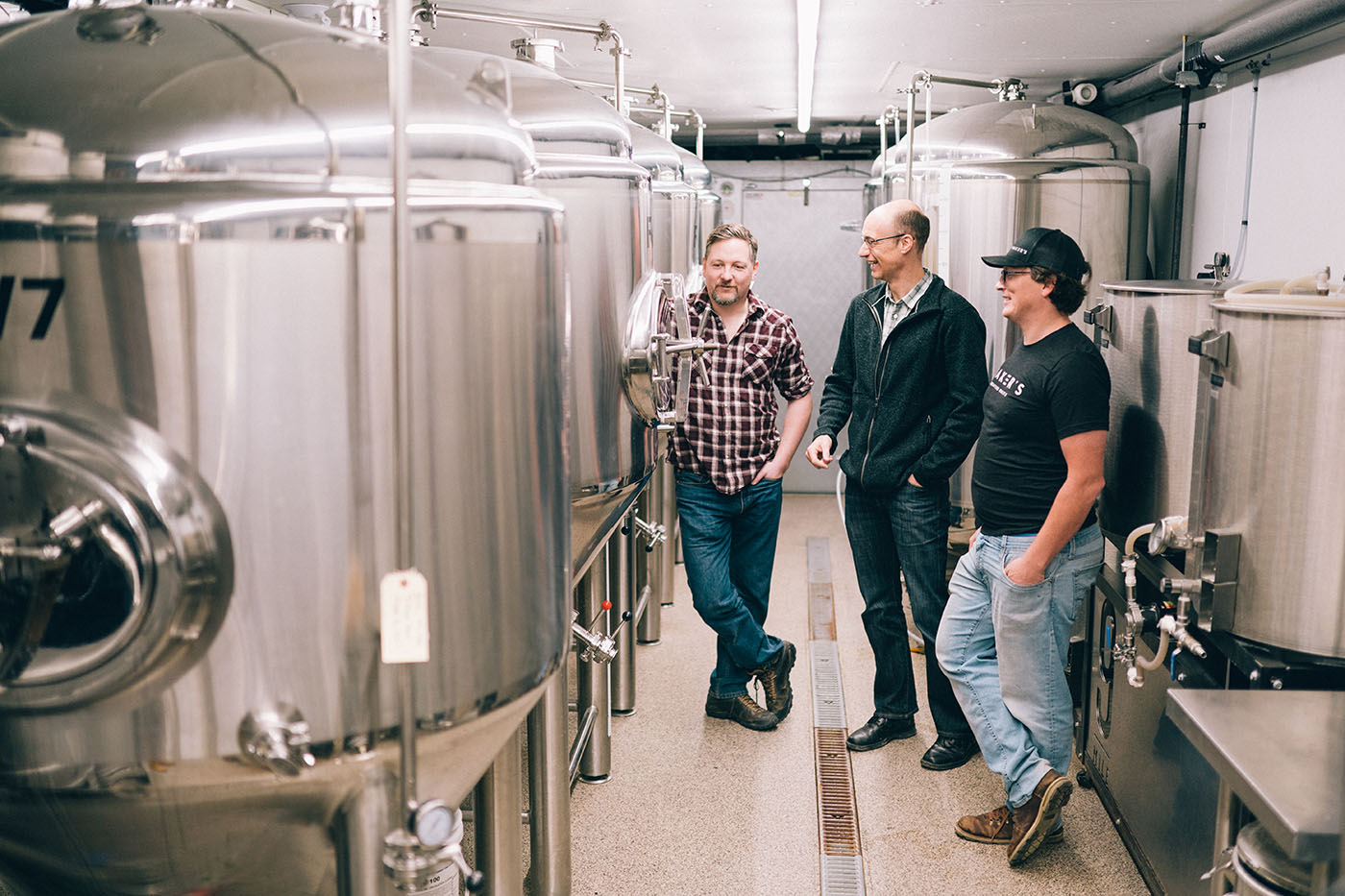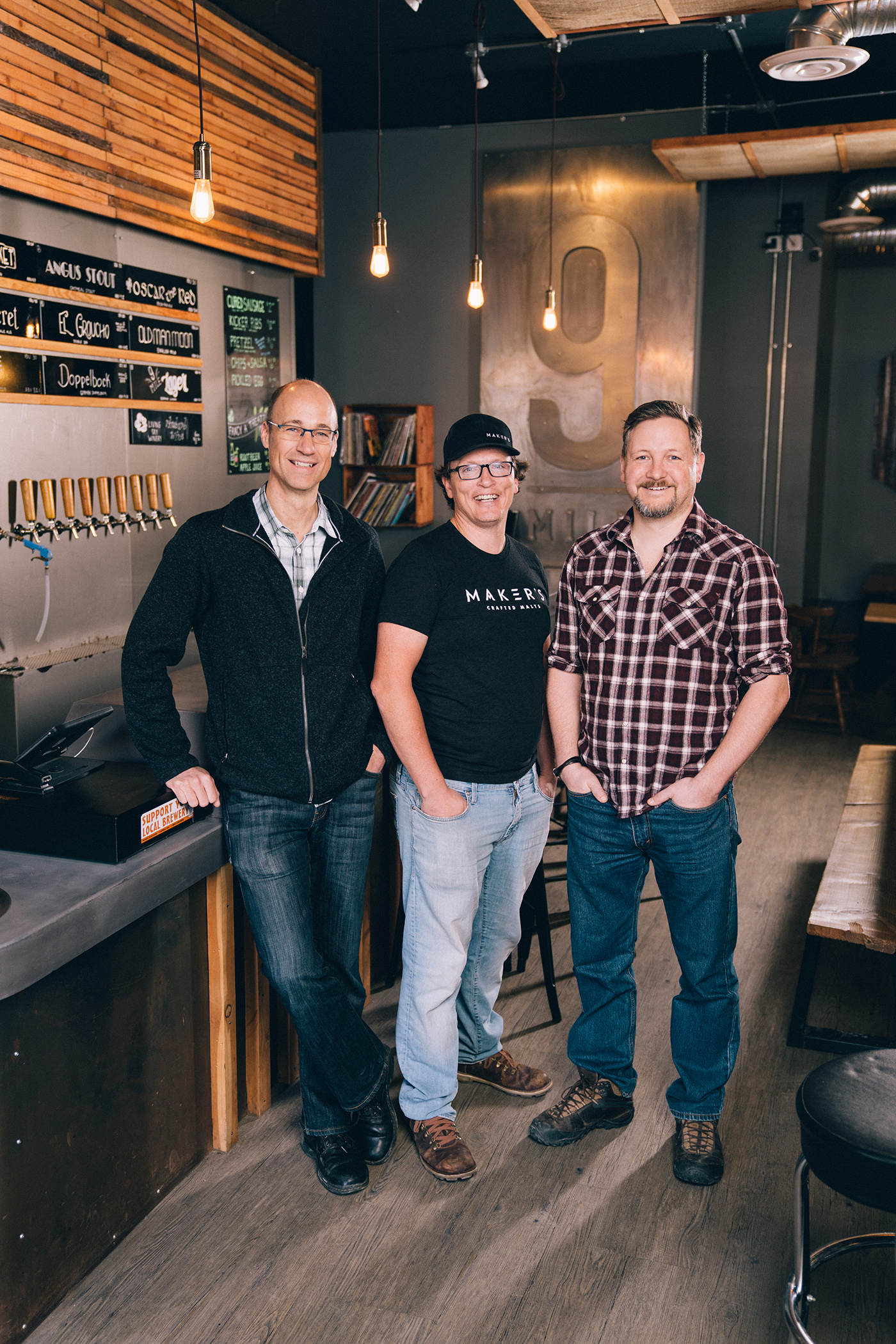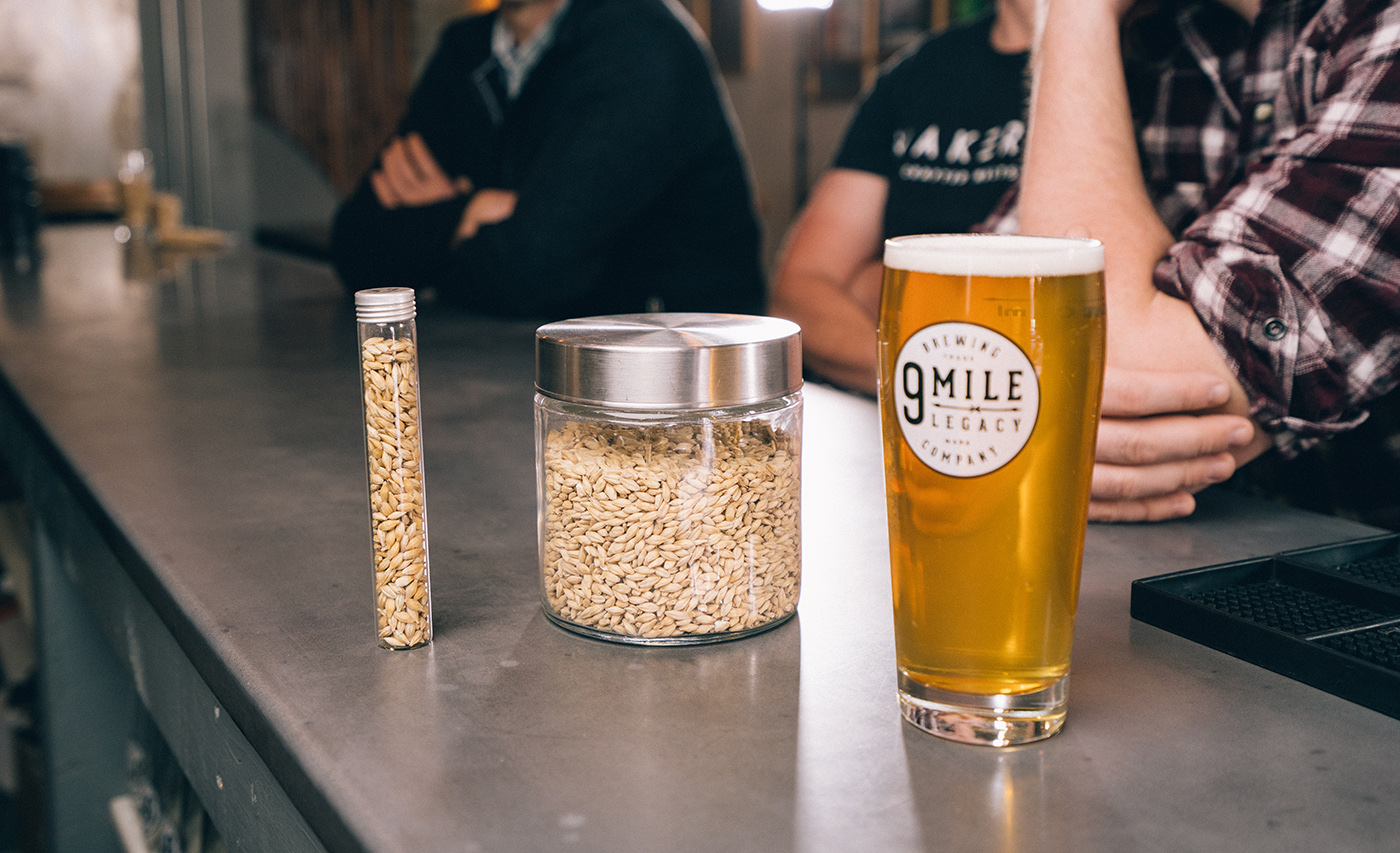Grain to growler
Menus boasting local produce have become the ideal for many restaurants around the world. When you think of a farm-to-table product, a plate full of plant-based proteins, organically grown berries and grain-fed poultry may come to mind. But what about what’s in your glass? A group of USask alumni are changing the game when it comes to farm-to-table expectations, entering the growing field of craft brewing as an avenue to test out the farm-to-table philosophy and proving that locally grown ingredients can stand the test of time on the Saskatchewan beer scene.
By LESLIE-ANN SCHLOSSER AND CHRIS MORINMatt Ramage, Studio D Photography
It’s Monday afternoon and work has already begun at 9 Mile Legacy microbrewery.
Tucked away on trendy 20th Street in Saskatoon’s Riversdale community, the narrow space with modern décor hums like the workings of a seasoned brewery.
In the back, the smell of malt fills the air as team members, led by cofounder and head brewer Garrett Pederson, work between the giant steel fermenters to perfect the perfect pint.
Back outside in the taproom, several taps of beer line the bar, all with a unique flavour and distinct taste. One of them is a new variety to the bunch, a 10.5 per cent Bow Tripel that has a bold taste and appeals to big beer drinkers.
The difference between this Bow Tripel and the Pilsner sitting in your fridge at home? The 9 Mile Legacy concoction boasts ingredients that were researched, developed, grown, processed, malted and perfected all within 60 kms of each other.
The final product that sits in a frosty glass on 20th Street started its life cycle just down the road in a laboratory at the USask Crop Research and Development lab.
Here, researcher Dr. Aaron Beattie (PhD’07) set out to develop a barley that would make everyone involved in the brewing process happy, from the farmers who grow it, the craft brewers who brew it to the drinkers who enjoy the final product.
A history of success
When it comes to brewing better beer, most lager lovers might not think to raise a glass in salute to the University of Saskatchewan.
Then again, for a number of craft brewers across Saskatchewan to industry giants such as Molson and Sapporo, it’s no secret that there is some refreshing research being done at the university when it comes to quality ingredients and expertise.
It’s a reputation that has certainly been well-earned: USask has been contributing to better brewing for the better part of a century, and it’s also one that Beattie, an associate professor in the College of Agriculture and Bioresources, is all too happy to carry on.
“The barley world is quite a tight-knit group. We work quite closely with other barley breeding programs in western Canada. We exchange data, and that happens over the entire course of producing a new variety of barley,” said Beattie, who adds that the Crop Development Centre (CDC) works with everyone from farmers to craft brewers to ensure a satisfying final product.

While the first barley varieties that came out of USask happened in the early 1920s, the university’s worldwide brew revolution didn’t land until 1981, when barley breeder Bryan Harvey (BSA’60, MSA’61) and his team released Harrington, a now-famous malting barley variety known for its colour and flavour as well as providing an excellent beer shelf life. Considered one of the greatest sud successes to come out of the university labs, Beattie said that the Harrington variety changed the face of malting and brewing around the world.
“It was a real step forward but it also put the U of S on the map worldwide,” said Beattie. “Since then CDC barley breeders, including my predecessor Brian Rossnagel, have continued to put out varieties that have had a large impact in western Canadian crops.”
The passion Beattie’s put into barley breeding is apparent in both his work at USask and in the bottles of the brewers he’s worked with. Barley breeding is challenging, said Beattie, but the end results are almost always rewarding, with an element of fun thrown in as well.
“It’s a fun community to be involved with and there’s always a lot of excitement around beer—people are passionate about it. And with the semi-recent craft brewing revolution that’s been going on in North American in the past 10 years, that’s brought a whole new interest in beer especially amongst younger consumers,” said Beattie.
While the CDC has released several varieties of barley since Harrington, one of the latest releases to make a splash is a variety called CDC Bow.
The benefits of using CDC Bow barley extends beyond its impressive growth performance and heavy yield capabilities, it’s also a chance to continue to engage with the local craft beer scene and collaborate with everyone involved in the process.
The variety was the star ingredient used in the Bow Project, a recent event that paired the product with craft breweries around Saskatchewan, with each coming up with their own uniquely-flavoured beer from the same ingredient.
“We don’t generally get to see the end product or people enjoying it on an intimate level… as a breeder, to see the people enjoying the downstream product of something you’ve been working on for the past eight years, it’s really quite something,” said Beattie.
Bringing out the new and interesting
Despite growing up farming with his family outside of Rosthern, Sask., Matt Enns (BSPT’04) initially pursued a career outside of agriculture.
“My dad often said ‘You’re not a farmer. You don’t take the interest a normal farmer would take so you should probably go find something else to do,’” laughed Enns.
When he came to USask, Enns ended up with a degree in physiotherapy alongside being a member of the Huskie men’s volleyball team.
He spent 15 years as a physiotherapist, but farming was never far behind as he continued to contribute to his family farm. When a neighbour put land up for sale, it only felt natural for Enns to purchase it and start farming full time.
But it didn’t take long for Enns to get the itch to extend his work outside just farming once again, which is why he established Maker’s Malt in 2017 and became the only craft malting company in Saskatchewan.
Malt is essentially barley that has been steeped, germinated and dried, and it is the final step barley needs to make on its way to becoming beer.
The benefits of producing malt at a smaller level and for local craft brewers appealed to Enns. He was intrigued by the community of craft beer enthusiasts growing in North America and predicted a similar trend wasn’t far behind for Saskatchewan, which was just starting to enhance its farm-to-table movement with more robust farmer markets and local restaurants when he started farming full time.
Being able to farm the product that makes its way to a malting stage is a rarity; usually barley farmers need to ship their yields to bigger malting companies where it is combined with other crops to create a consistent product. But Enns had an urge to become more than a commodity producer to bigger grain purchasers.

“I know we’re producing the best stuff but it’s just going into a big vat with everyone else’s stuff and coming out the other end pretty generic. You see that disconnect and think ‘how can we capture that?’ The craft beer explosion gave us an avenue,” said Enns.
As such, Maker’s Malt focuses on enhancing barley and malt quality rather than chasing maximum yields.
“Going from grain to growler puts us in the unique position as maltsters to control our entire chain of production,” said Enns.
When he heard about the work Beattie was doing at USask through seed partner SeCan, Enns didn’t hesitate to get on board with the Bow Project. He supplied malt to 14 breweries throughout Saskatchewan. The brewers were then tasked with taking the variety and creating a wide range of beers. The ultimate goal was to see how the barley would respond in a commercial brewing setting and through different beer styles.
“I love the fact that this barley comes from the U of S,” said Enns. “When you look at our typical commodities and where they end up, it’s mind-blowing that we can have this high-tech operation that is world class right here in our small setting and take it all the way through full circle.”
The final product
A venture like the Bow Project relies on the strengths of small-batch local maltsters and brewers. The ability to produce a variety of diverse beers and explore new ingredients is unique to their small scale when compared to larger corporate breweries, who typically live and die by their tried-and-true brewing ingredients and methods. In short, small craft breweries do not have as much to lose if a batch fails, but the payoff is often worth the risk.
“Beer only has four main ingredients. If you change one of those ingredients you are definitely going to change how your processes work and likely the outcomes,” said Enns. “There’s so much risk to every part of the equation. You need these small enterprises to start bringing out new and interesting things.”
Back at 9 Mile Legacy, Shawn Moen (LLB’05) proudly pours another pint in the taproom.
As a former lawyer, he took a leap of faith from a professional practice into the craft beer game. Like Enns, he doesn’t have any regrets about changing professions and is happy to be part of the growing Saskatchewan craft beer scene.
“When I was starting out in law school I was always interested in business and doing alternative things with my degree,” he recalled.
9 Mile Legacy was one of the 14 Saskatchewan breweries who were approached to test the bow variety as part of the Bow Project. Moen gives full credit to his co-founder Pederson for constructing the maltforward recipe that became the Bow Tripel.
“How did it perform in the glass? It was awesome. We had a lot of fun with it,” said Moen.

9 Mile Legacy is built on a sense of community and collaborating—it’s not uncommon to find locals from the surrounding businesses sipping on pints while playing cards on a Thursday afternoon, which is why the Bow Project fit perfectly within their brand.
“It gives me a lot of pride in what we’re doing. To be able to see the pride in people’s eyes when they’re drinking barley that they grew,” said Moen.
“It’s two fold—we’re adding value to our agricultural product and we’re adding value for our communities. By making that beer and telling that story, we’re reminding people of what being good neighbours is all about and what working together is all about.”


